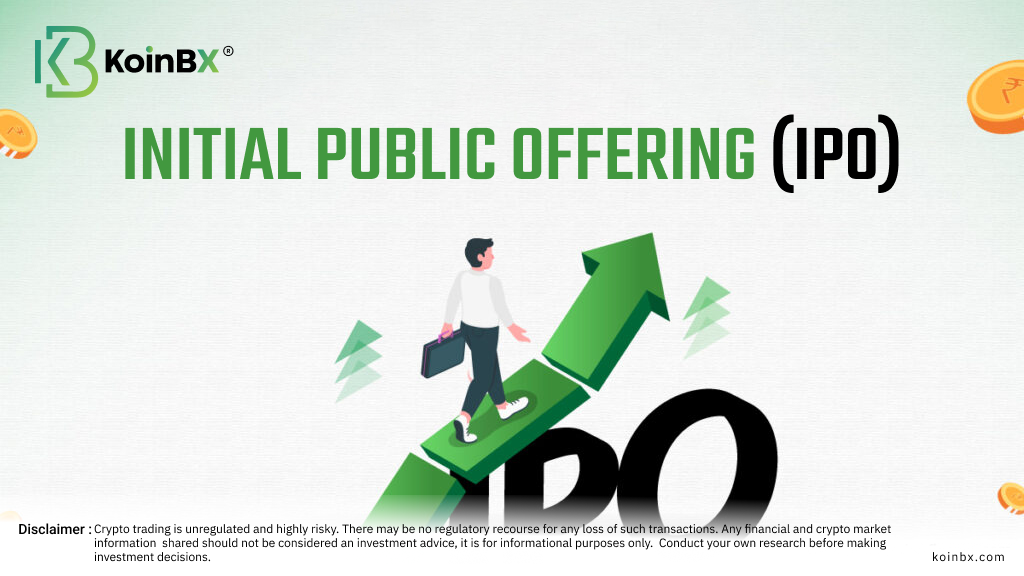What is an IPO?
An initial public offering (IPO) is the process by which a private corporation offers shares to the public for the first time through a new stock issuance. An IPO is a process by which a company raises capital from public investors, typically through the use of a share premium for existing private investors. This transition from private to public offers private investors a significant opportunity to realize returns on their investments. At the same time, it also provides an opportunity for public investors to take part in the offering.
How Does IPO Work?
Prior to the IPO, a company is considered to be privately held. As a private pre-IPO company, the company has expanded with a relatively limited number of shareholders, including early investors such as the founders, their families, and friends, as well as professional investors including venture capitalists and angel investors.
The IPO is a significant milestone, enabling a company to raise substantial capital, which increases its capacity for expansion and growth. Furthermore, the increased transparency and credibility of the share listing can also assist the company in obtaining better terms when applying for loans.
When a company has reached the point in its development where it considers that it is sufficiently developed to comply with the requirements of the SEC regulations in addition to the advantages and liabilities to its public shareholders, the company will begin to disclose its intention to go public.
This stage of growth typically occurs after a company has achieved a private valuation in the range of $1 billion or more, also referred to as a unicorn. Private companies at different valuations with robust fundamentals and demonstrated profitability potential may also be eligible for IPOs, depending on the competition in the market and their capacity to meet the listing criteria.
Underwriting due diligence is the process of pricing an IPO of a company. When a company is publicly traded, the private share ownership of the company is transferred to the public, and the shares of the existing private shareholders become available for trading at the public market price. Special provisions for the transfer of share ownership between the public and private shareholders may also be included in share underwriting.
The public market provides a broad range of investors the opportunity to purchase shares and contribute to the company’s equity. The public comprises any individual investor or institutional investor wishing to invest in the company.
The total number of shares sold by the company and the price at which those shares are sold are the primary determinants of the value of the new shareholders' equity of the company. While shareholders' equity still represents the equity of the company when it is both publicly and privately owned, in the case of an IPO, the shareholders' equity significantly increases due to the substantial injection of cash from the primary issue.
Also Read: What is Initial Coin Offering (ICO)?
History of IPOs
IPOs have long been a popular concept on Wall Street and among investors. The Dutch are widely regarded as the originator of modern IPOs, as they were the first to offer shares of the Dutch East India Company to the public. Since then, IPO has been utilized by companies to acquire equity capital from public shareholders by issuing public share ownership.
Over the years, IPOs have been associated with both increases and decreases in issuance. Industry-specific trends in issuance can also be attributed to innovation and other economic drivers. Technology IPOs were particularly prevalent during the dotcom bubble, as unprofitable startups raced to list on the stock exchange.
2008 was the year with the lowest number of IPOs due to the financial crisis. The recession following the financial crisis caused a halt to IPOs, and new listings were scarce for a period of time. In recent years, the focus on IPOs has shifted to the so-called "unicorns" of startup companies, which have achieved a private valuation of over $1 billion and are the subject of extensive speculation by investors and the media as to whether or not these companies will go public through an IPO or remain private.
Process of IPO
The IPO process is composed of two distinct stages. The first stage is known as the "pre-marketing" phase, while the second stage is the "IPO". Companies interested in an IPO may either solicit private bids from underwriters or make a public statement to attract investor interest. Underwriters are the primary participants in the IPO process and are appointed by the issuer. An issuer may choose one or more underwriters to co-manage various aspects of the IPO process. Underwriters participate in all aspects of an IPO, including due diligence, preparation of documents, filing, advertising, and issuance.
Advantages
One of the primary benefits for the company is access to capital from a wide range of public investors. This facilitates easier acquisition transactions, such as share conversions, and enhances the company’s visibility, credibility, and public reputation, potentially leading to increased sales and profits. Additionally, the increased transparency that comes with quarterly reporting can often result in more advantageous credit lending conditions than those offered by a private company.
Secondary offerings offer the potential to generate additional funding in the future, as well as the ability to attract and retain experienced management and talented personnel through the use of liquid stock equity options (such as ESOPs). Additionally, IPOs can provide a company with a competitive advantage in terms of the capital cost for both equity and debt.
Disadvantages
Companies may encounter various drawbacks when going public and might opt for alternative approaches. Key drawbacks include the high costs of IPOs, as well as the long-term expenses associated with maintaining a public company, which are often unrelated to other operational costs.
Fluctuating share prices can be a source of distraction for a company's management team, who may be remunerated and rewarded on the basis of share price performance rather than on the basis of actual financial performance. In addition, a company becomes subject to disclosure requirements regarding financial information, accounting information, tax information, and other business data. In the course of such disclosure, a company may be required to disclose confidential information and business practices that could be advantageous to competitors.
Leadership and governance by boards of directors can impede the retention of experienced and risk-taking executives. Private ownership is always a viable option. Companies may also seek bids for a public buyout. There may also be some other options available to companies.
Final Thoughts
Investors tend to be drawn to IPOs due to the high media attention associated with them, some of which may be induced by the company itself. In general, IPOs are attractive to investors due to their ability to fluctuate in price on the day of and shortly after the IPO. While this volatility can sometimes lead to substantial gains, it can also result in significant losses. Investors should, therefore, evaluate each IPO based on the company’s prospectus, alongside their own financial situation and risk tolerance.
Download KoinBX Android App | Download KoinBX iOS App
Disclaimer: Any financial and crypto market information shared should not be considered investment advice. It is for informational purposes only. Conduct your own research before making investment decisions. Crypto trading is unregulated and highly risky. There may be no regulatory recourse for any loss of such transactions.






Comments